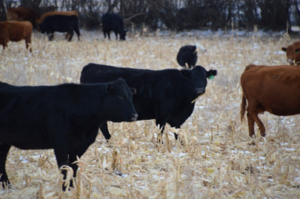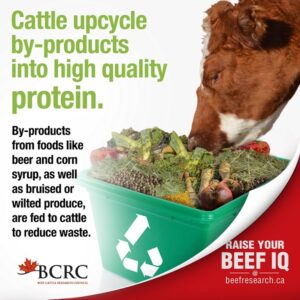Waste Not Want Not
This article written by Dr. Reynold Bergen, BCRC Science Director, originally appeared in the April 2021 issue of Canadian Cattlemen magazine and is reprinted on the BCRC Blog with permission of the publisher.
When I was a kid, “no dessert if you don’t finish your supper” encouraged us to eat everything on our plates. Others grew up with the guilt-based “children are starving in the third world” approach. There are more than twice as many people on earth today as there were 40 years ago, so issues like food security and “food loss and waste” are gaining attention. Every year in Canada nearly a tonne of food is lost or wasted per person. The federal Food Waste Challenge is part of Canada’s commitment to the United Nations (UN) goal to reduce global food loss and waste by 50% by 2030. Food waste is more than just the unidentifiable and vaguely menacing leftovers in the back of your fridge. In fact, food loss and waste are defined as any crop or livestock product that doesn’t directly reach a human mouth.

But some of this food loss and waste does reach human mouths indirectly, through livestock. As part of a Beef Cluster project, Dr. Kim Ominski and collaborators from the Universities of Manitoba and Lethbridge and Agriculture Canada are examining how livestock help reduce food loss and waste. Their first report “Utilization of by-products and food waste in livestock production systems: A Canadian Perspective” will be published in Animal Frontiers. Here are some of their key findings so far.
The UN’s Food and Agriculture Organization (FAO) distinguishes between “food loss” and “food waste”. Food waste happens in the store, the restaurant, or the home. Some companies have set goals to reduce or eliminate food waste in their operations as part of their corporate responsibility initiatives. For example, some retail stores donate bruised produce or unsold, outdated bakery products to food banks or famers to use as livestock feed, as Jill Burkhardt explained in Cattlemen’s November issue. Feeding plate waste from homes or restaurants to livestock is often illegal unless it’s been re-cooked to kill potential pathogens. In fact, unregulated cross-border sales of unprocessed plate waste for pig feed may have contributed the spread of African Swine Flu in parts of Europe and Asia.
Food loss occurs during production, storage and processing, long before it ever reaches the store, restaurant or home. This definition of food loss is incredibly broad. Crops that get hailed out, chaff, kernels that go out the back of the combine, bumper crops that exceed bin capacity and sprout in the pile, barley that fails to grade malt, and wheat that fails to meet milling standards are all examples of on-farm food loss. By-products from food processing including broken or small potatoes, over-cooked chips and French fries, beet pulp, hulls, screenings, distillers’ grains and oilseed meals are also considered food loss.
This broad definition of “food loss” is problematic for two reasons. Firstly, humans can’t or won’t normally eat these things. If they did, they either couldn’t digest them due to their high fiber content, or they might become sick (e.g. mycotoxins). Perhaps these things shouldn’t be classed as “food” to begin with.
But secondly, just because these things can’t be used for food doesn’t mean they can’t be used for feed. These crops and by-products can be fed to livestock, which can handle higher levels of fiber or mycotoxins than people can. So a considerable amount of “lost food” does reach human mouths – it just reaches humans indirectly, through eggs, milk or meat. Without livestock, this food truly would be lost, and the fertilizer, herbicide and fuel inputs (and all their accompanying environmental impacts) would also be completely wasted. Without livestock, that food might be landfilled or used to generate biogas or biofuel. But biogas and biofuel won’t feed a growing population, unlike eggs, milk, meat or beef.
Cattle have some unique advantages. Because they can digest high fiber by-products very effectively, cattle can consume up to 50% distillers’ grains in their diet, much more than pigs (15%) or chickens (10%). High fiber hulls from oats, soybeans and sunflowers are useful for cattle, but not hogs or chickens. Beef cattle can also cope with higher levels of mycotoxins in the diet than monogastrics.
Unlike other livestock, beef cattle can go out and collect “lost food” for themselves; they can graze a hailed-out or frozen crop, for example. No harvest and transportation is needed. So cattle may be a uniquely efficient solution to some of the food loss problem. In fact, cattle may even be viewed as a miraculous solution. For example, straw isn’t considered food, so straw isn’t food loss. But straw is 50% of the biomass from a grain field. Cattle can digest straw as a part of their diet, just like they can digest the grass on marginal lands that won’t support crops. That’s a net gain of food for mankind, thanks to beef cattle.
Government also has a practical role in addressing regulatory barriers that contribute to food loss. By-products can’t legally be sold or used in a livestock ration until the Canadian Food Inspection Agency has approved and added them to Schedule IV of the Feeds Act. For example, quinoa, faba beans and hemp oil are increasingly popular with consumers. The by-products from these crops could replace some of the grains and protein supplements that are currently used livestock diets, but not until they’ve received regulatory approval.
This team will also measure how upcycling “food waste and food” through livestock benefits overall greenhouse gas emissions, land use and biodiversity. These researchers are involved in international initiatives at the FAO, and will use these research results to help policy makers around the world understand that beef cattle aren’t the problem – they’re part of the solution.
The Beef Cattle Research Council is funded by the Canadian Beef Cattle Check-Off. The BCRC partners with Agriculture and Agri-Food Canada, provincial beef industry groups and governments to advance research and technology transfer supporting the Canadian beef industry’s vision to be recognized as a preferred supplier of healthy, high quality beef, cattle and genetics.
Click here to subscribe to the BCRC Blog and receive email notifications when new content is posted.
The sharing or reprinting of BCRC Blog articles is typically welcome and encouraged, however this article requires permission of the original publisher.
We welcome your questions, comments and suggestions. Contact us directly or generate public discussion by posting your thoughts below.
